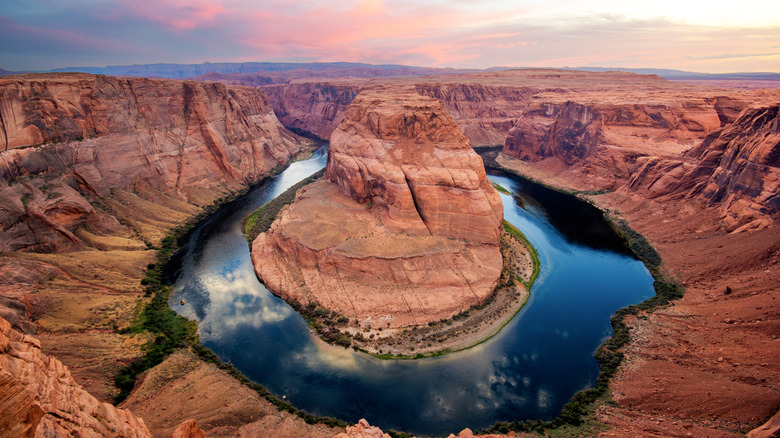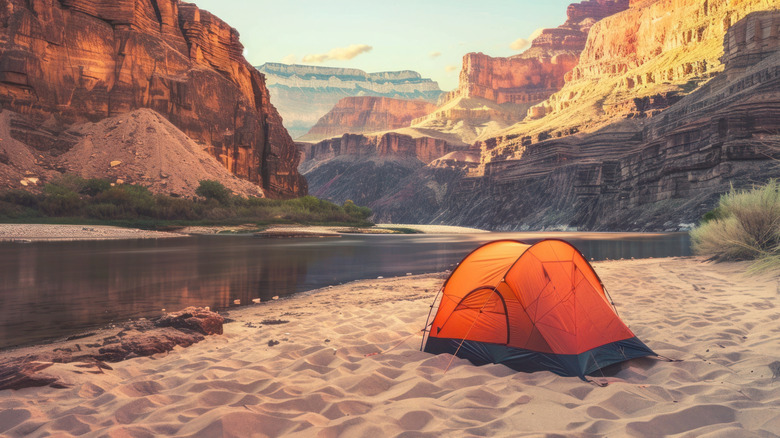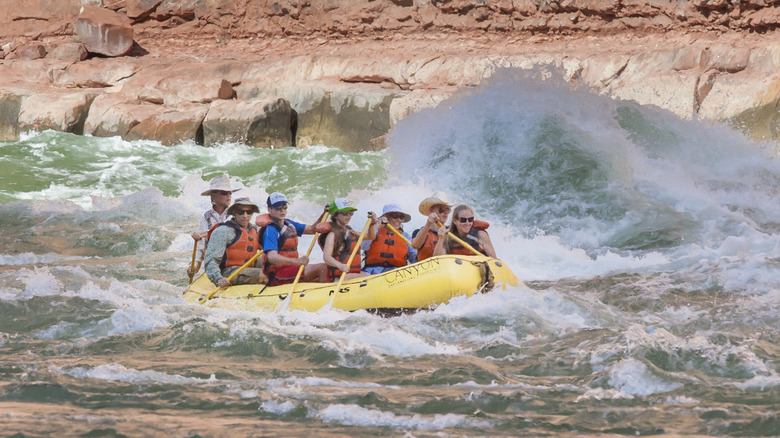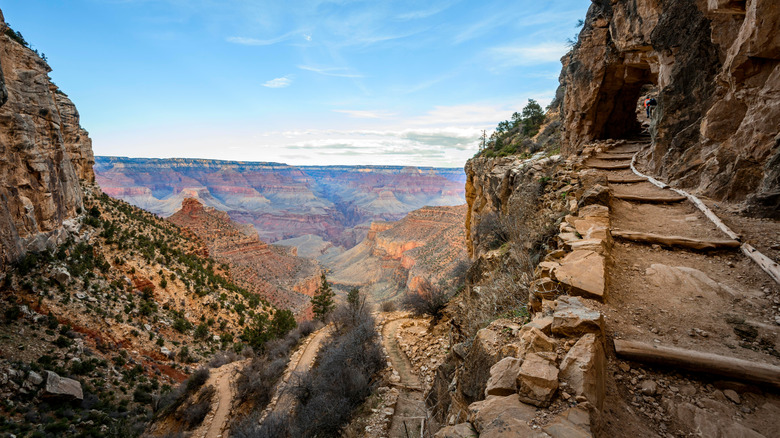The Best Way To Choose A Grand Canyon River Rafting Trip For Your Time, Budget, And Appetite For Adventure
Spanning 277 miles and attaining a depth of over 6,000 feet, Arizona's Grand Canyon is one of the most mesmerizing places on planet Earth. Whether you gaze at its vastness on an unforgettable canyon helicopter tour or stare into the abyss from the canyon's rim, these birds eye views are so stunning they'll likely stay with you your entire life. Equally magnificent, however, is viewing the canyon from its innermost depths, an otherworldly environment where the raging Colorado River meets dusty cactus-studded desert and towering, fire-splashed cliffs — nature's artistry at her most dramatic.
For the ultimate experience of the inner canyon, embark on a rafting trip on the Colorado River, which winds like a serpent all along the canyon bottom. In some sections, the mighty river is still and smooth, reflecting the finest details of the canyon walls like a shiny mirror. Elsewhere, it narrows into a churning chasm, with rapids that quickly transform from mild and refreshing to thrashing, liquid hell. But you don't have to be a thrill seeker to enjoy a Grand Canyon rafting trip. Many flavors of trips are available for rafters of all ages and levels of experience — short trips, long trips, calm trips, wild trips, you name it. The hardest part is deciding which kind of adventure best matches your needs, preferences, and dreams.
Planning your rafting trip: time and budget considerations
The first thing to consider is the desired length of your rafting adventure. If you don't have the time or budget for a longer trip, a few canyon outfitters offer one-day smooth water and whitewater trips. While these short trips can be inspiring and refreshing — especially on a sweltering summer day — they provide only a small dose of canyon magic, a bit like a teaser for a longer adventure.
Wilderness River Adventures offers half-day rafting excursions from Lees Ferry, just upstream from where the Grand Canyon officially begins. These scenic and relaxing out-and-back trips on motorized rafts are on smooth water (no rapids), traveling to and from the Colorado River's stunning hairpin turn, Horseshoe Bend,one of the most photographed destinations in Arizona. The price for this trip is $113.82 for kids and $129 for adults, not including the park entrance fee of $15 per person. Alternatively, Hualapai River Runners offers one-day whitewater trips (with rapids) deep in the canyon. These are more expensive at $429 per adult and $386 per child, picnic lunch included.
Overnight and multi-day trips
On a multi-day adventure, you cover many more river miles and see more wonders of the inner canyon — its contrasting ecosystems, colorful geological strata, elusive wildlife, and more. Then you get to sleep in a tent in the Grand Canyon at night, under stars that shine brilliantly in the black velvet sky, hundreds of miles away from any urban light pollution. More than a dozencanyon outfitters offer commercial trips, which vary by length (from overnights to 18 days) and type of boat (large motorized rafts, oared rafts, paddle rafts, and dories). An important detail affecting trip length and cost is the section of river to be rafted. Shorter trips may be limited to just the upper or lower canyon, while longer trips include both.
On these commercial trips, expect to spend a few hundred for overnight trips, around $700 for 3-day trips, $2,000 — $4,000 for week-long trips, and up to $7,000 for the longest trip (18 days). Open to experienced rafters only, a final option is a non-commercial private trip between 12—25 days. It's not a given that just anyone will be able obtain permits for a private trip, though, as the national park issues them via a weighted lottery system.
Water- and boat-related variables: rapids, speed, and exercise
The Grand Canyon boasts more than 100 rapids, many with descriptive names, such as the notoriously terrifying Crystal and the thunderous Lava Falls. Some of the one-day trips are on smooth water only, which could be appealing to families with small children, for example. On the other hand, if a wild ride is what you're seeking, be sure your trip includes the lower canyon, where most of the biggest rapids are concentrated. Whitewater lovers should also consider trips in July or August, when water volumes peak due to monsoon rains and upstream dam releases.
Exercise- and speed-related considerations include whether you want to paddle your boat and how quickly you want to move downstream. Those who don't want to paddle and/or prefer to move faster to cover more river miles in a shorter timeframe should choose a trip with motorized rafts. Meanwhile, others may actually want the experience (and exercise) of paddling their boat and/or using a mode of transportation that's quieter, with less environmental impact. If you're in one of these groups, select a human-powered expedition on paddle rafts, oar boats, dories, or some combination of the above. Human-powered trips can be exhausting but will also allow you to build some serious upper body strength over the course of your adventure.
Hike your heart out — or not
How much and what kind of hiking do you want to do as part of your rafting adventure? Some outfitters build exhilarating day hikes into expeditions, giving guests opportunities to explore fascinating locations in the inner canyon that can't be reached by boat. For example, some trips include day hikes to the bucket-list destination of Havasu Falls and/or the spectacular Little Colorado River, known for its shimmering, powder-blue waters.
Which section of the river you're rafting will also affect the kinds of hiking you'll be doing. River trips limited to the upper canyon usually require a grueling uphill hike from Phantom Ranch (where these trips end in the inner canyon) to the South Rim. Conversely, trips limited to the lower canyon require a brutal downhill hike from the South Rim to the same location. These rim to canyon trails require a high level of fitness and are extremely steep and rugged. Because of risks like hyperthermia and falling, they are some of the most dangerous trails in the U.S. If you aren't up for this, choose a trip that includes motorized transportation to and from the starting and ending points.




